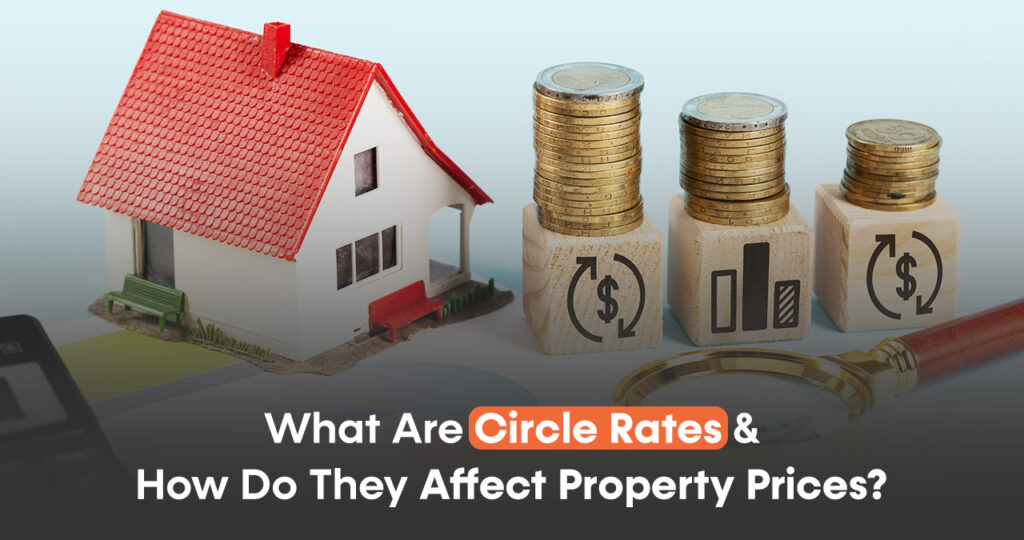In the ever-evolving Indian real estate market, property transactions involve several layers of costs and regulations that buyers and sellers must navigate. Among these, circle rates stand out as a critical factor influencing property prices and transaction dynamics. Knowing circular prices is crucial whether you’re a seller in Bengaluru, Delhi, Mumbai, or another city, or a seasoned investment. But what exactly are circle rates, and how do they shape property prices in India? This article provides a comprehensive exploration of circle rates, their determination, significance, and their direct and indirect effects on the Indian real estate market. With insights tailored to the latest trends as of 2025, we’ll unravel this complex yet vital aspect of property dealings.
What Are Circle Rates?
Circle rates, often called guideline values or ready reckoner rates in some states, are the minimum property valuation rates established by state governments across India. These rates serve as a benchmark for registering properties during sales or transfers, ensuring that no property is transacted below this threshold for official purposes. In essence, circle rates reflect the government’s estimation of a property’s worth based on its location, type, and other relevant factors.
For example, a residential flat in a posh locality like South Delhi will have a higher circle rate than a similar property in a less developed area. These rates are primarily used to calculate stamp duty and registration charges, which are mandatory taxes and fees levied during property transactions. By setting a floor price, circle rates play a pivotal role in standardizing valuations and ensuring transparency in the real estate sector.
How Are Circle Rates Determined in India?
The process of determining circle rates is a detailed exercise managed by the state government’s revenue department or local municipal bodies. Each state in India has its own methodology, but the core principles remain consistent. Here’s what influences circle rates:
- Location: Properties in prime urban areas, such as Bandra in Mumbai or Golf Links in Delhi, have higher circle rates due to their desirability and infrastructure.
- Property Type: Residential, commercial, and industrial properties have distinct rates, reflecting their differing market values and potential returns.
- Amenities & Infrastructure: Proximity to schools, hospitals, metro stations, or highways can push circle rates upward.
- Market Trends: Prevailing property prices and transaction data in an area help align circle rates with real-time market conditions.
State governments typically revised circle rates periodically—often annually or biennially—to keep them in sync with economic growth and real estate trends. For example, Maharashtra raised Mumbai’s circular rates by an average of 5% in 2023 to account for growing property values. This revision process ensures that circle rates remain relevant and effective in their purpose.
Why Are Circle Rates Important?
Several critical functions in the Indian real estate ecosystem make them indispensable for both the government and property stakeholders. Here are the key reasons:
- Revenue Generation: Stamp duty and registration fees, calculated based on circle rates, are significant revenue sources for state governments. Higher circle rates ensure higher tax collections.
- Curbing Undervaluation: By setting a minimum valuation, circle rates prevent sellers and buyers from underreporting transaction values to evade taxes, reducing black money circulation.
- Standardization: They provide a uniform basis for property valuation, aiding legal processes, loan approvals, and tax assessments.
In short, circle rates are a tool to maintain fairness, transparency, and fiscal discipline in the real estate market, protecting both governmental interests and market integrity.
How Do Circle Rates Affect Property Prices in India?
The interplay between circle rates and property prices is intricate, impacting everything from buyer affordability to seller pricing strategies. Let’s dissect this relationship into its component parts:
Impact on Stamp Duty and Transaction Costs
In India, stamp duty is calculated on the higher of the circle rate or the actual transaction price. This rule has a direct bearing on the total cost of buying a property. For example:
- If a property in Bengaluru has a circle rate of Rs. 80,000 per square meter but is sold at Rs. 70,000, the stamp duty will still be based on Rs. 80,000.
- Conversely, if the market price is Rs. 90,000, the stamp duty will apply to that higher amount.
Since stamp duty rates in India range from 5% to 7% (sometimes higher depending on the state), this additional cost can significantly increase the buyer’s outlay. When circle rates exceed market rates, buyers face a higher financial burden, which can dampen demand and pressure sellers to lower their asking prices to make deals viable. On the flip side, when circle rates are lower than market rates, the stamp duty aligns with the transaction price, potentially stabilizing or boosting demand without inflating costs unnecessarily.
Influence on Market Dynamics and Property Values
Circle rates don’t just affect transaction costs—they also influence market perceptions and pricing behavior:
- Upward Revision Signals Value: When governments hike circle rates, it often signals that an area is gaining value—due to infrastructure projects, for instance. Sellers may then increase their prices to match or exceed the new circle rates, pushing property values upward. For example, a metro line extension in Pune might prompt a circle rate hike, encouraging sellers to demand more.
- Lower Rates and Stagnation: If circle rates lag behind market trends, it might suggest an area is undervalued or stagnating, potentially keeping property prices in check or even depressing them.
Additionally, circle rates can affect supply and demand dynamics. High circle rates might deter buyers, reducing transaction volumes and forcing sellers to adjust prices downward. Low circle rates, however, could stimulate demand, driving prices up as buyers compete in a buoyant market.

Delhi (2019): The Delhi government raised circle rates by up to 20% in certain areas. This led to a temporary slowdown in property registrations as buyers balked at the higher stamp duty. Sellers in some segments had to lower prices to maintain sales momentum, illustrating how elevated circle rates can suppress demand.
Mumbai (2020): During the COVID-19 pandemic, Maharashtra slashed stamp duty rates temporarily (not circle rates directly), boosting registrations by 30% in some months. This policy showed how reducing transaction costs can revive property prices and market activity.
Bengaluru (2023): Karnataka revised circle rates upward by 10-15% in key areas to align with market growth. While this increased government revenue, it raised concerns about affordability, particularly in the affordable housing segment, where buyers are more price-sensitive.
These cases underscore that circle rates can either stimulate or stifle the market, depending on how they align with actual property values.
Variations Across Market Segments
The impact of circle rates varies across property types and buyer segments:
- Luxury Properties: In high-end markets (e.g., South Mumbai or Gurgaon), where market prices far exceed circle rates, the effect of circle rate changes is often minimal. Buyers here focus more on prestige and amenities than stamp duty costs.
- Affordable Housing: In budget segments, higher circle rates can significantly erode affordability, as stamp duty forms a larger proportion of the total cost. This can suppress demand and keep prices lower than they might otherwise be.
Role in Property Taxes and Loans
Beyond stamp duty, circle rates influence property tax calculations in some municipalities, where higher rates mean higher annual taxes for owners. This increased holding cost might prompt sellers to demand more to offset expenses, indirectly affecting prices.
For home loans, banks often consider circle rates during property valuation. If a circle rate is lower than the transaction price, the loan amount might be capped at a percentage of the circle rate, affecting buyer financing and, consequently, market activity.
Challenges and Controversies Surrounding Circle Rates
Setting circle rates is a balancing act fraught with challenges:
- Accuracy: Rates that are too high can inflate transaction costs and stall the market, while rates that are too low lead to revenue losses and undervaluation risks.
- Disparities: Variations between neighboring localities can create confusion or perceptions of unfairness. For instance, two adjacent colonies in Delhi might have vastly different circle rates despite similar amenities.
- Market Uncertainty: Frequent or unpredictable revisions can disrupt planning for buyers and sellers, affecting market sentiment.
Critics also argue that circle rates sometimes fail to curb black money effectively. If rates are unrealistically high, buyers and sellers might resort to under-the-table cash deals to offset stamp duty, undermining transparency.
Recent Developments and Future Trends
As of 2025, Indian states are adapting circle rate policies to modern needs:
- Transparency: States like Maharashtra and Karnataka now publish circle rates online, improving accessibility for the public.
- Rate Revisions: In 2023, Mumbai saw a 5% average increase in circle rates, while Bengaluru implemented hikes of 10-15% in select zones, reflecting robust market growth.
- Tech Integration: Discussions are underway to use AI and data analytics for more dynamic, market-linked circle rates, potentially updated quarterly rather than annually.
Looking ahead, potential reforms include:
- Dynamic Rates: Frequent updates based on real-time transaction data.
- Progressive Stamp Duty: Lower rates for higher-value properties to encourage transparency in luxury deals.
- Standardization: A unified approach across states to reduce disparities.
These changes could make the real estate market more responsive and equitable.
Also Read - Affordable Housing Schemes in India: 2025 Updates & Eligibility
Conclusion
Circle rates are a cornerstone of the Indian real estate market, directly affecting property prices through their influence on stamp duty and transaction costs. They also shape market dynamics by signaling value shifts and altering buyer-seller behavior. While they help generate revenue and curb tax evasion, their effectiveness depends on how well they mirror market realities.
For buyers and sellers, grasping the role of circle rates is key to making informed decisions in a competitive landscape. As India’s real estate sector grows, policymakers must refine circle rate frameworks to balance revenue goals with market vitality, ensuring a transparent and thriving property market for all. If you are looking to buy a property in Chandigarh Tricity, you can explore Lets Rentz for zero brokerage properties.



